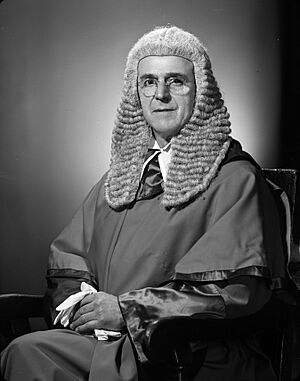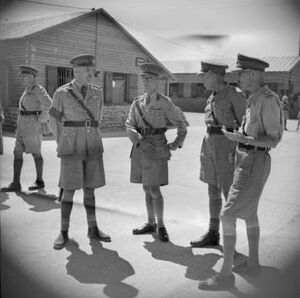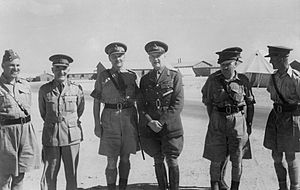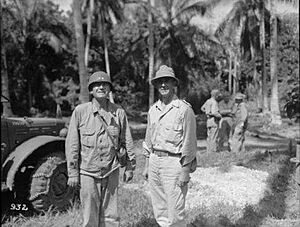Harold Barrowclough facts for kids
Quick facts for kids
Sir Harold Barrowclough
|
|
|---|---|

Barrowclough, circa 1954
|
|
| 8th Chief Justice of New Zealand | |
| In office 17 November 1953 – 17 January 1966 |
|
| Nominated by | Sidney Holland |
| Appointed by | The Lord Norrie |
| Preceded by | Humphrey O'Leary |
| Succeeded by | Richard Wild |
| Personal details | |
| Born | 23 June 1894 Masterton, New Zealand |
| Died | 4 March 1972 (aged 77) Auckland, New Zealand |
| Military service | |
| Branch/service | New Zealand Military Forces |
| Years of service | 1913–1931 1940–1945 |
| Rank | Major General |
| Commands | Northern Division 3rd Division |
| Battles/wars | First World War
Second World War |
| Awards | Knight Commander of the Order of St Michael and St George Companion of the Order of the Bath Distinguished Service Order & Bar Military Cross Efficiency Decoration Mentioned in dispatches (2) Croix de Guerre (France) War Cross (Greece) Legion of Merit (United States) |
Major General Sir Harold Eric Barrowclough (born June 23, 1894 – died March 4, 1972) was a very important New Zealander. He was a brave soldier who fought in both World War I and World War II. After his military career, he became a top lawyer and then the Chief Justice of New Zealand, which is the highest judge in the country. He held this important role from 1953 to 1966.
Harold Barrowclough was born in Masterton, New Zealand. He started studying law and joined the army reserves in 1913. When World War I began, he volunteered to serve overseas. He fought on the Western Front and became a battalion commander. After the war, he finished his law degree and became a successful lawyer. He also continued to serve in the army reserves.
When World War II started, Barrowclough volunteered again. He led an infantry brigade in Greece and North Africa. Later, he commanded the 3rd Division during the Solomon Islands campaign in the Pacific. After the war, he returned to law. In 1953, he was appointed Chief Justice of New Zealand. He helped create a permanent Court of Appeal for New Zealand. He retired in 1966 and passed away in Auckland in 1972.
Contents
Early Life and Education
Harold Eric Barrowclough was born in Masterton, New Zealand, on June 23, 1894. His father was a civil engineer who later became a teacher. Harold went to Palmerston North Boys' High School. He was a great student and athlete. He was a prefect and won a university scholarship in 1912. The next year, he began studying law at the University of Otago. He also joined the Territorial Force, which is like an army reserve.
Serving in World War I
When World War I started, Harold Barrowclough volunteered for the New Zealand Expeditionary Force (NZEF) in January 1915. He quickly showed strong leadership skills. Within four months, he became a second lieutenant. He went overseas in October 1915 as a lieutenant with the New Zealand Rifle Brigade. He briefly served in the Senussi campaign in the Middle East.
In 1916, his brigade moved to the Western Front in Europe. Barrowclough was seen as an excellent officer. In March, he was promoted to captain. Three months later, he became a company commander. In September 1916, he earned a Military Cross for his bravery during the Battle of the Somme. He led an attack on a German strong point and connected with a British division. He also received the French Croix de Guerre for the same brave actions.
In June 1917, he was wounded in the back and sent to England to recover. After healing, he commanded reserve battalions in England. He returned to France in March 1918 as a temporary major. He was soon recommended to command a battalion. In August 1918, he was promoted to lieutenant colonel and took command of the 4th Battalion, New Zealand Rifle Brigade. A month later, during the Hundred Days Offensive, he received a Distinguished Service Order (DSO). This was for his leadership during a German counterattack near Havrincourt Wood. He was praised for his courage and skill in leading his men.
In the capture of Le Quesnoy, the last major action for the New Zealand Division, he led his battalion over the town's walls. He was later mentioned in official reports for his role in this battle. After the war, while his division was in Germany, he helped set up an education program for soldiers. He then returned to New Zealand and left the army.
Between the World Wars
After World War I, Barrowclough went back to his law studies at Otago University. He graduated in 1921 and started his own law practice in Dunedin. He also taught law part-time. He rejoined the Territorial Force and commanded the 1st Battalion, Otago Regiment, from 1924 to 1929. In 1930, he was promoted to colonel and given command of the 3rd Infantry Brigade.
He left the Territorial Force in 1931 when he joined a law firm in Auckland called Russell, McVeagh, Bagnall and Macky. He quickly became a well-known lawyer in Auckland.
By the mid-1930s, Barrowclough was worried about New Zealand's military. It was getting weaker because of a lack of money and the end of compulsory military training. In 1936, he helped restart the National Defence League of New Zealand (NDL). This group wanted to improve New Zealand's defenses before another war. However, the government at the time did not pay much attention to their concerns.
Serving in World War II

Before World War II began, Barrowclough offered his services to the New Zealand Military Forces. His offer was accepted when the Second New Zealand Expeditionary Force (2NZEF) was formed. This force was led by Major General Bernard Freyberg. In 1940, when the 2nd New Zealand Division was created, Barrowclough was promoted to brigadier. He was put in charge of its 6th Infantry Brigade. He left New Zealand in May 1940. He spent four months in England commanding parts of the 2nd New Zealand Division. His own brigade continued on to Egypt as planned.
Campaigns in Greece and North Africa
Barrowclough rejoined his 6th Infantry Brigade in October 1940. He was not happy with their training, so he focused a lot on improving it. This hard work meant his brigade performed well during the campaign in Greece in April 1941. After the fighting in Greece, he defended Freyberg's leadership, even though some other officers criticized it.
He later fought in Operation Crusader, a campaign to help lift the siege of Tobruk in North Africa. During this battle, his brigade captured parts of the German Afrika Korps headquarters. However, he was very eager to capture Point 175, an important hill. This led to heavy losses for one of his battalions. Even though Point 175 was taken, his brigade could only hold it for a few days before German attacks forced them to retreat. For his leadership during Operation Crusader, he received a bar to his DSO. He had already been given the Greek War Cross and was mentioned in official reports for his work in Greece.

Fighting in the Pacific
The New Zealand government asked for Barrowclough to command the Pacific Section of the 2NZEF, which was based in Fiji. This was a very important job because Imperial Japan had entered the war. Fiji was the last line of defense for New Zealand. Barrowclough left for New Zealand in early 1942. But while he was traveling, the current commander of the Pacific Section became very ill. He was sent home and quickly replaced by Major General Owen Mead. When Barrowclough arrived in New Zealand, he was disappointed that his expected command was no longer available. He was then made commander of the Northern Division with the rank of major general. He was in charge of defending the upper North Island of New Zealand. For the next few months, he reorganized and trained his new command.
Barrowclough got another chance to serve overseas after Mead died in a plane crash in July 1942. At that time, the Pacific Section was being brought back to New Zealand to become a division for fighting in the South Pacific. In August, Barrowclough was named commander of this new unit, now called the 3rd New Zealand Division. He immediately changed its structure. He replaced many older officers with those who had experience fighting in Greece, Crete, or North Africa. He also started new training programs. Most of the division's soldiers had been building forts in Fiji, so they hadn't had much combat training.
The 3rd Division moved to New Caledonia to take over garrison duty. This allowed American forces who were there to go fight in the Battle of Guadalcanal. Barrowclough knew his division was the only large non-American unit in an area commanded by Americans. So, he asked for, and received, permission to ask the New Zealand Government for instructions if he felt the division was going into battles that could cause many casualties.
Barrowclough arrived in New Caledonia in November 1942, but most of his division didn't arrive until January 1943. Once there, his division began training for amphibious landings (attacks from the sea) and jungle warfare. This prepared them for future battles. Barrowclough also worked on the difficult task of getting supplies and fitting his division into the American command system. The 3rd Division was smaller than a normal infantry division, having only two infantry brigades instead of three. He tried to get it expanded, but New Zealand couldn't provide enough soldiers for two full divisions. The government preferred to keep the 2nd New Zealand Division, which was in North Africa, at full strength. Barrowclough was unhappy about this.
In August 1943, Barrowclough learned that his division would join the Solomon Islands campaign. They would take part in three major amphibious operations. The first was in September 1943. The 14th Brigade landed around the coast of Vella Lavella during the Battle of Vella Lavella. The New Zealanders performed well, and American commanders praised their work.
Next, in October 1943, was the Battle of the Treasury Islands. This involved the 8th Brigade and was the first time New Zealand forces made an amphibious landing under enemy fire since the Gallipoli landing in 1915. This operation, like Vella Lavella, was a success, and the Japanese resistance was quickly overcome. In early 1944, Barrowclough commanded a force of nearly 16,500 men during the Battle of the Green Islands. Only a third of these were from his own division; the rest were American forces.
Barrowclough had always known that New Zealand might not be able to keep both the 3rd Division and the 2nd New Zealand Division fighting. As long as Japan was a threat to New Zealand, there was a reason to keep the 3rd Division. But once Japan was no longer a major concern, New Zealand faced a shortage of manpower. This led to the decision to disband the 3rd Division. This would provide more soldiers for the 2nd New Zealand Division, which was fighting in Italy. It also allowed men to return to important jobs in New Zealand.
Despite Barrowclough's protests, the disbandment began in April 1944. Nearly 1,900 men returned to New Zealand, with more following in the next few months. By June 1944, what was left of the division was in New Caledonia. In September, the disbandment was made official and finished the next month. This left Barrowclough without a command. He hoped for a suitable position with the 2nd New Zealand Division, maybe even taking over from Freyberg. But this did not happen. Instead, he was sent to observe the British Army's 21st Army Group. In late 1945, he was discharged from the military. For his service in the Pacific, he received several awards, including the United States Legion of Merit and was made a Companion of the Order of the Bath.
Later Life and Chief Justice Role
After leaving the military, Barrowclough went back to his law career. His law firm had struggled during the war because of a lack of staff. Rebuilding his practice took up a lot of his time. In 1953, he moved to Wellington to become the Chief Justice of New Zealand. This is the highest judge in the country. He also received the Queen Elizabeth II Coronation Medal. The next year, he was given an honorary law degree from Otago University. He also became a member of the Privy Council, a high court that advises the British monarch. He was appointed a Knight Commander of the Order of St Michael and St George and was knighted by Queen Elizabeth II during her visit to New Zealand in 1954.
As Chief Justice, he created the permanent Court of Appeal of New Zealand. This court hears appeals from lower courts. After he retired in January 1966, Barrowclough returned to Auckland. He passed away on March 4, 1972, at the age of 77. He had three children. His wife, Mary, whom he married in 1921, had passed away in 1964.
In his will, Barrowclough left money to the University of Otago to create a scholarship for law students. In 2009, Palmerston North Boys' High School, his old school, started leadership and achievement programs named in his honor.


